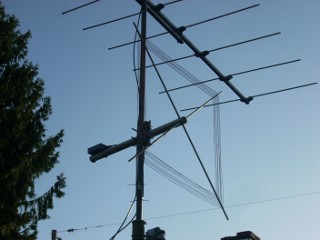The Eclipse's Effects On Radio Propagation
The recordings on this page started as an experiment to observe the effects
of the solar eclipse on the propagation of class C AM broadcast stations. These
stations are found on 1230, 1240, 1340, 1400, 1450, and 1490 kHz. As these are
relatively low powered stations intended to reach small geographic areas, there
are many stations operating on each of these five frequencies. At night, each
of these frequencies is a cacophony of signals unless, of course, one is fairly close to the transmitter.
The initial hypothesis was that as the zone of totality swept eastward, one
station should be able to dominate each frequency, possibly followed by another
station and perhaps even a third. The receiving antenna used was the homebuilt
amplified loop shown below. This antenna has a figure-8 pickup pattern, which
was needed in order to minimize interference from local stations on the class C
frequencies (1230 and 1450 kHz) or on adjacent channels.

The experiment was carried out in Hillsboro, OR, where the eclipse reached
its maximum around 10:18 A.M. PDT. The antenna was rotated N-S so that one
of the nulls would be directed toward KRYN (1230 kHz) and KBPS (1450 kHz).
The class C frequencies often had multiple weak signals that faded in and out
over each other. The first frequency checked was 1230 kHz, but nothing of
interest was heard there. An unexpected result was that many signals from
Seattle could be heard, even though the zone of totality swept south of
Hillsboro.
- 1240 kHz This was the first aircheck, recorded
at 10:11 A.M. The strong station at the beginning of the clip might KQEN
(Roseburg, OR); the station underneath it might be KEJO (Corvallis, OR). It
is difficult to tell.
- 1300 kHz The station playing music is most
likely KAPL (Phoenix, OR). There are two additional stations (one with
a man's voice and one with a woman's) that could be KACI (The Dalles, OR) and
KKOL (Seattle, WA).
- 1310 kHz This recording was made at the point
of maximum darkness. The station is very likely KNPT
(Newport, OR), because the station's Website confirms that Clark Howard
aired during this timeslot.
- 1380 kHz One of the stations is most likely
KRKO (Everett, WA), which airs a sports format. The other remains
unidentified.
- 1400 kHz This is more typical of what was heard
on the class C frequencies. There is nothing to be heard here.
- 1440 kHz Judging by the location of the
business advertising in this clip, the station is KMED (Medford, OR).
- 1470 kHz KELA (Centralia, WA)
- 1540 kHz Most likely, this is KXPA (Bellvue,
WA), based on the programming.
- 1620 kHz KYIZ (Renton, WA)
- 1680 kHz KNTS (Seattle, WA)
- 1690 kHz The closest station on this frequency
is KFSG (Roseville, CA). The interference is from adjacent KNTS.
Local time was 10:29 A.M. when the 1690 kHz was recorded. At this point, the
antenna was rotated east-west to receive stations that might experience
favorable propagation as the eclipse approached them. Scanning was started
from the bottom of the band.
- 560 kHz KPQ (Wenatchee, WA); this station
could be heard with the loop either north-south or east-west. However, adjacent
channel interference from KOAC was severe in the north-south orientation.
- 570 kHz KVI (Seattlee, WA); it is quite
unusual that the reception would be this good with the antenna pointed the
wrong way.
- 670 kHz KBOI (Boise, ID)
- 690 kHz KRCO (Prineville, OR); it is not
certain whether this is groundwave reception or if the eclipse played a
part.
- 700 kHz KGRV (Winston, OR); the reception is
surprisingly good, given that the antenna is pointed the wrong way.
- 730 kHz The tuba playing faintly above the
noise floor is most likely KDBI (Boise, ID).
- 1160 kHz KSL (Salt Lake City, UT); this
aircheck was recorded at 10:41 A.M. Nighttime reception of KSL is much
better.
- 1240 kHz This is an unidentifiable mix of
stations.
- 1280 kHz KIT (Yakima, WA)
- 1300 kHz The station running the advertisement
is KLER (Orofino, ID). The station playing music is most likely KAPL (Phoenix,
OR).
- 1310 kHz This clip was recorded at 10:52 A.M.
The station could not be identified. At this point, much of the skip had begun
to disappear.
Aircheck Archive Page
Frugal Web Server Home.